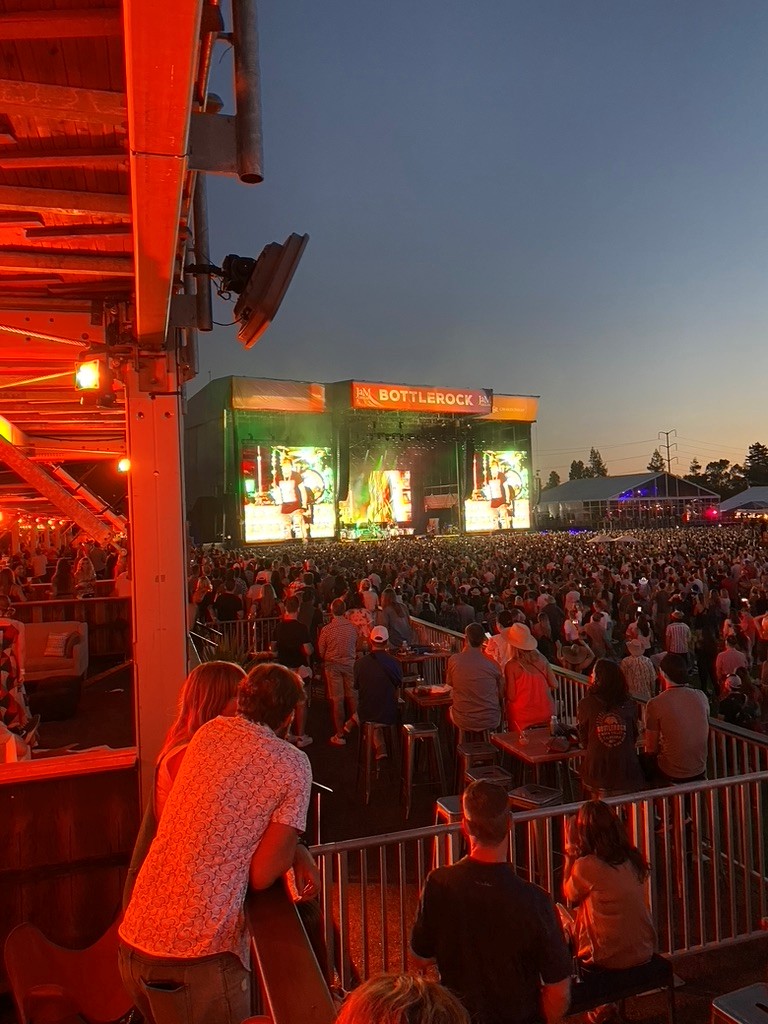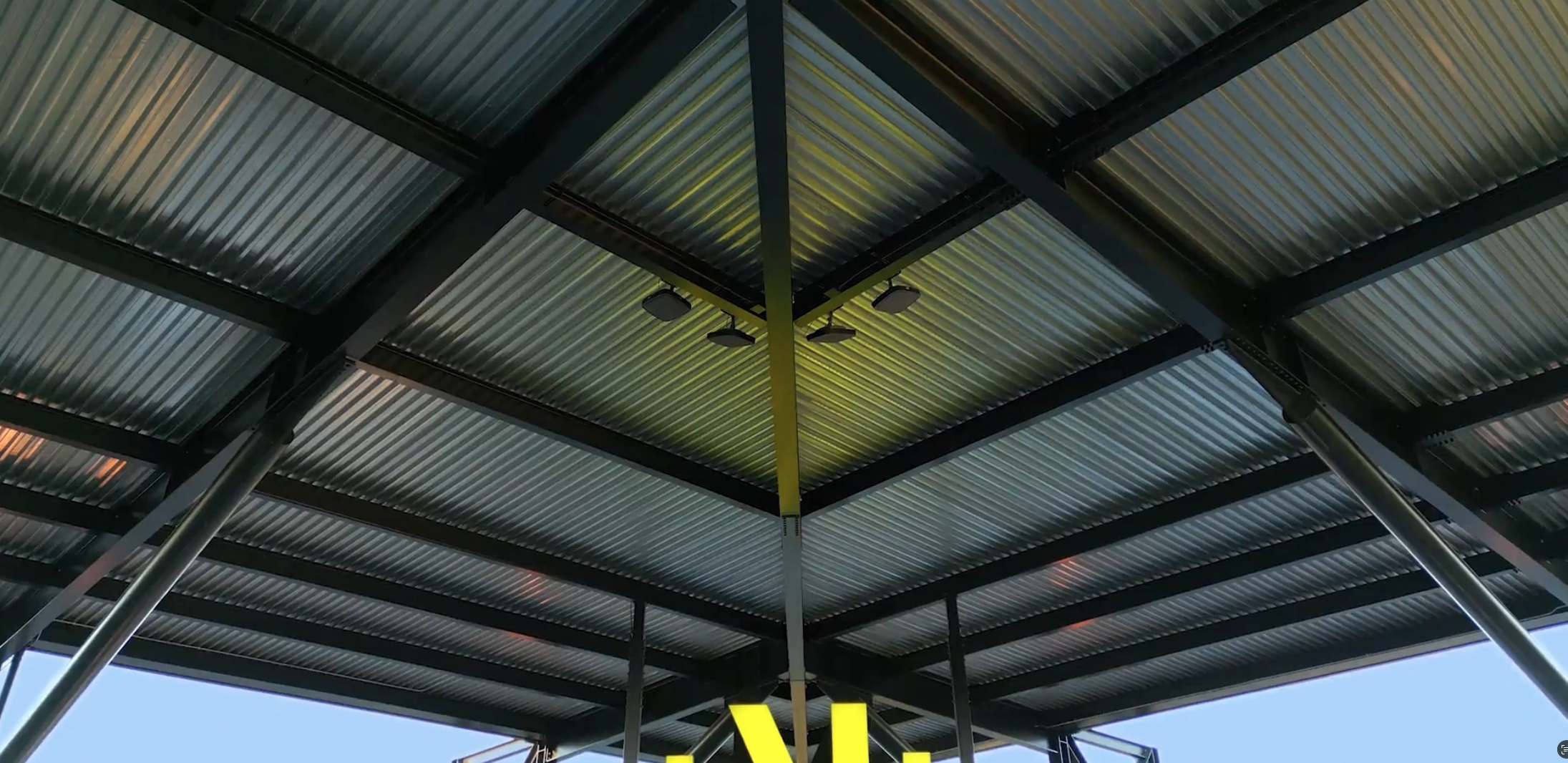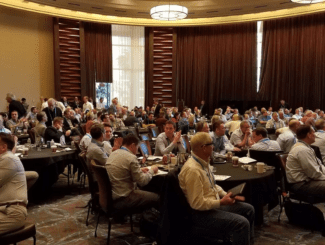After more than a decade of trying to fit fan-facing wireless antennas into stadiums with varying levels of success, teams and venue owners have a powerful new tool to assist them in their quest to build networks that are both high performing and economically sound: The “long reach” or “hyper-directional” wireless antenna.

Available in forms for both cellular and Wi-Fi networks, newer versions of wireless network antennas that can extend the communication range between antenna and client device are proving to be the missing link that was previously sought in stadium network design. Instead of trying to improve performance by bringing antennas closer to users, either by installing them under stadium seats or in the handrails, venues can now deliver most of the powerful communications their customers desire simply by installing hyper-directional (called this for its ability to point precise beams in desired directions) antenna devices in the rafters.
While such antenna technology has been publicly available for several years, it takes time to overcome the “accepted wisdom” that has seen under-seat and/or handrail antenna placements dominate the stadium-network landscape.
But live performance measurements from early mover deployments of hyper-directional antennas, combined with some very obvious construction and maintenance benefits, is spurring some rapid movement toward using such gear for new deployments or upgrades for stadium cellular and Wi-Fi fan-facing networks.
While increased performance per device is driving some of the moves, a large added benefit of a hyper-directional network design could be its immediate ability to not just save money on network construction and operation, but to also contribute directly to a venue’s bottom line. By providing a better experience for the most premium of premium seating areas, those near the court or pitch, or for concerts, on the main floor itself, the hyper-directional antennas can provide a positive economic story beyond the technical aspects.
Why does hyper-directional matter? Follow the money
For most of the short history of stadium wireless networks, venues focused closely on technology, trying to build networks that could keep up with demand. Early attempts to “monetize” things like Wi-Fi networks through charging fans to use the services or by selling advertising mostly fell flat. In the end, most venues adopted the theory that good wireless connectivity was a utility crucial to attracting and keeping fans, like electricity or water. Paying multiple millions for network builds became table stakes for venues of professional-league size.
But as wireless demand for more bandwidth and faster connection speeds continued to increase year by year, costs to deploy more-robust networks grew apace. New versions of Wi-Fi and cellular technology like Wi-Fi 6 and cellular 5G arrived to help performance, but with equipment that had significantly higher price tags. And as networks became more dense, the costs of building new under-seat or handrail deployments and servicing and cleaning around all those devices also became more expensive.

Even with lots of deployment history and design creativity, the so-called “proximate” network designs (where antennas are close to seats) still couldn’t provide a premium service to an entire venue, especially falling flat in the ability to cover stadium floor or field areas, which is where premium concert and event tickets are sold. As more venues seek to schedule more concert and entertainment events to bring in more money, the desire to bring a premium wireless experience to premium-priced seating areas becomes even more important.
If the older technology and designs couldn’t deliver, something new needed to be found. And by focusing on changing the equation at the antenna level, the builders of hyper-directional antennas have produced a solution that not only performs better technically, but also produces potential significant savings in construction and maintenance, delivering powerful, more-easily upgraded systems at a fraction of the cost of traditional network builds.
How do hyper-directional antennas work?
Hyper-directional antennas came about when people found different ways to “focus” a wireless signal from an antenna, instead of spreading it around in many directions. On the cellular side, a company called MatSing developed a unique curved “Lens” enclosure for its antennas that basically mimics the action of a human eyeball, focusing the signals like your eye focuses on images you look at.
On the Wi-Fi side, some innovative work with radio frequency (RF) filtering allowed two companies, Everest and Cisco, to develop products that had operable ranges of about three times the reach of a regular stadium Wi-Fi antenna. For Cisco, the filtering in its hyper-directional products “acts like earmuffs” on the antenna, limiting the so-called “east to west traffic,” according to Matt Swartz, a distinguished engineer who leads Cisco’s hyper-directional antenna development. By limiting the side lobe contention, the hyper-directional Wi-Fi antennas can increase their power to the directed signals, allowing for the greater communication reach.

In both the cellular and Wi-Fi hyper-directional antennas, there are multiple radios that can be digitally turned in different directions, which lessens the number of individual antennas that need to be installed. One of the larger MatSing lens antennas can hold up to 48 different radios. The Cisco and Everest products held four radios each, with Everest having four radios for Wi-Fi (three 5 GHz and one 2.4 GHz) while the Cisco product had three for different Wi-Fi bands (two 5 GHz and one 2.4 GHz) and one for internal communication.
Why does the ability to place antennas farther away make sense? It’s because when it comes to deploying fan-facing wireless antennas in a venue, the designer is at the mercy of the architecture, and to what kind of “mounting assets” it provides, be it a wall, a post, an overhang, a handrail, or space to drill to underneath the seat floor.
And once the costly and time-consuming installation of proximate network devices is done, network operators must figure out ways to lessen the interference between antenna devices, and to try to find ways to make sure fans’ phones are finding the closest and best antenna connection.
According to network designers, one of the hardest parts about configuring an under-seat or handrail network is figuring out how close separate antennas can be placed without interfering with each other. The basic premise of most under-seat networks also uses the fans’ bodies themselves as a kind of game-day buffer, since the water in a human body does a fairly good job at blocking Wi-Fi signals. Deep technical knowledge in RF systems is necessary to design such stadium-wide networks, with each new network a unique problem to solve.

But such designs can suffer in performance if a stadium isn’t full, or if large groups of people get up and leave their seats at any given time. Stadium Wi-Fi network deployment stories are full of tales where phones from fans on one side of the bowl are trying without success to connect to a Wi-Fi antenna on the other side of the stadium, because they can “see” the signal even if it’s weak.
Hyper-directional antennas, on the other hand, can be precisely tuned to cover only a small portion of the seating bowl or stadium floor. And because they have a clear line-of-sight path from antenna to user, interference is at a minimum, compared to antennas used in proximate designs.
Being able to place the hyper-directional antennas far away from the seats has several other benefits: First, it is more aesthetically pleasing since the antenna gear is not under a seat, and is out of any normal fan’s line of sight to the game action or event; second, it is typically easier and cheaper to install since most venues already have a type of working rigging system in their rafters, for things like lighting and stadium sound; third, that same rigging infrastructure makes the gear potentially easier to maintain and upgrade, as opposed to working on devices under seats or in handrails.
For stadiums or arenas with retractable seating — a common deployment in arenas that switch formats from hockey to basketball to concerts on a frequent basis — putting antennas overhead means you don’t have to worry about installing or maintaining operation of under-seat or handrail antennas that would roll back and forth with the retractable seats. And as stated before, hyper-directional antennas can be mounted in the center of the ceiling to provide top-down coverage to the playing surface or stadium floor, to cover floor seating for concerts. Currently, many arenas without hyper-directional antennas will try to cover floor seating with some kind of temporary network, which again involves a lot of deployment and breakdown time, as well as reduced network performance.
Since they typically contain more radios per unit than standard wireless antennas, hyper-directional antennas are more costly per device. But a network using hyper-directional antennas also uses a lower number of actual devices, which saves on construction and cabling costs compared to proximate networks.
Another savings on the opex side is the fact that under-seat antennas have proven to be a time-consuming addition to stadium cleaning. Not only must the devices be completely water- and temperature-proofed so they can be steamwashed with the rest of the floor, they also have proven to be very effective traps for stadium waste, which can contribute to the time and labor needed for stadium cleaning crews.
Cranes and weight support
The new hyper-directional antennas are not without their own unique set of deployment challenges. In the case of the largest MatSing antennas — which are ball-shaped devices with a diameter of about 6 feet — venues must make sure the roof structures can support the weight, and may also need cranes and pulley systems to get the antennas into place. Venues must also design for the remote devices that power the antennas, and the greater number of connector cables for the multi-antenna MatSing devices.
Venue IT teams also need to plan and monitor antenna placement location, to ensure that they aren’t moved or impacted by temporary rigging-placed equipment from concerts or other “guest” tenants. For most venues, there are already such processes in place and models to follow from the other devices that are already located in the upper infrastructure, like sound speaker arrays and venue lighting.
Short profiles of current providers
The following are some short profiles of the top current providers in the hyper-directional stadium antenna market, along with contact information for each company.

MatSing produces a large line of antennas for cellular deployments, for in-building, outdoors and macro network environments. For stadiums and arenas, MatSing’s innovative “Lens Antennas” use a unique curved or spherical enclosure to produce hyper-directional attributes, with an approximate top reach of 175 feet from antenna to client device for its farthest-reaching devices. The company has reported numerous customer wins at both arena-size venues and NFL-size football stadiums in the past few years.
Most recently, MatSing antennas were used by AT&T and Verizon to upgrade their coverage at the Caesars Superdome ahead of Super Bowl 59. At that game the two MNOs reported a combined total of 67 terabytes of data used in and around the stadium on game day. MatSing antennas are also prominent in the distributed antenna system (DAS) designs at Allegiant Stadium in Las Vegas and AT&T Stadium in Arlington, Texas.

With a longtime dedicated division that focuses on Sports, Media and Entertainment, Cisco is the largest provider of networking equipment and services to the large public venue industry. In 2021, Cisco introduced its Catalyst 9104 hyper-directional antenna, also known by its internal code name “Marlin.” With an ability to connect to clients at distances of 200 feet or more, the “Marlin” changed the game for stadium Wi-Fi network deployments.
Following small deployments of the 9104 antenna at several venues including Allegiant Stadium in Las Vegas, the first full-venue deployment of 9104 antennas went live at Geodis Park in Nashville in 2022. Since then the 9104 has found numerous arena and stadium customers who are taking advantage of its better performance and easier deployment to augment their fan-facing Wi-Fi networks.

UPDATE, 5/17/25: Our report that Fortinet had acquired Everest Networks was confirmed by Fortinet.
Everest Networks, a pioneer in the development of hyper-directional antennas for Wi-Fi networks, is apparently still producing new equipment, even though the company remains mostly publicly silent about its operations. Once a division of electronics giant Panasonic, Everest made a splash in the stadium networking world in 2017 when it announced it had been selected by the NFL’s Philadelphia Eagles to provide its hyper-directional Wi-Fi gear for a fan-facing network at Lincoln Financial Field.
Shortly thereafter, the Everest division left Panasonic and became a standalone company. Though the company’s gear was also selected for Wi-Fi networks at MetLife Stadium in East Rutherford, N.J., home of the NFL’s New York Jets and New York Giants, there has been little publicly heard about Everest since then.
While the Eagles have confirmed that their stadium still uses Everest equipment, the team would not comment on the deployment. According to a MetLife Stadium representative, Everest gear is also still in use there at the present moment. Everest has not responded to requests for information from Stadium Tech Report.









